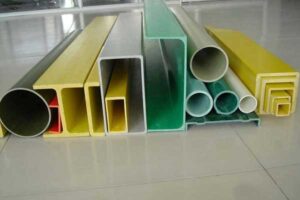Some fiberglass pultruded profiles applications require the fire retardant property, and different fire retardant rates have different functions. Two types of North America and Europe fire retardant standards are listed below:

FRP Products
1. ASTM E 84
It is standard test method for surface burning characteristics of of building materials.
The flame spread index and smoke developed index values obtained by the ASTM E 84 test are used by code officials and regulatory agencies in the acceptance of interior finish materials for various applications. The most widely accepted classification system is described in the National Fire Protection Association publication NFPA 101 Life Safety Code
1. 2006 International Building Code
a. Section 803 Wall and Ceiling Finishes, Paragraph 803.1 General states, “Interior wall and ceiling finishes shall be classified in accordance with ASTM E- 84. Such interior finish materials shall be grouped in the following classes in accordance with their flame spread and smoke-developed indexes.
i. Class A: Flame Spread 0-25; smoke-developed 0-450
ii. Class B: Flame Spread 26-75; smoke-developed 0-450
iii. Class C: Flame Spread 76-200; smoke-developed 0-450
Class A, B, and C correspond to type I, II, and III respectively in other codes such as SBCCI, BOCA, ICBO. They do not preclude a material being otherwise classified by the authority of jurisdiction.
2. UL 94, the Standard for Safety of Flammability of Plastic Materials for Parts in Devices and Appliances testing is a plastics flammability standard released by Underwriters Laboratories of the USA.
The standard classifies plastics according to how they burn in various orientations and thicknesses. From lowest (least flame-retardant) to highest (most flame-retardant), the classifications are:
HB: slow burning on a horizontal specimen; burning rate < 76 mm/min for thickness < 3 mm and burning stops before 100 mm
V-2 burning stops within 30 seconds on a vertical specimen; drips of flaming particles are allowed.
V-1: burning stops within 30 seconds on a vertical specimen; drips of particles allowed as long as they are not inflamed.
V-0: burning stops within 10 seconds on a vertical specimen; drips of particles allowed as long as they are not inflamed.
5VB: burning stops within 60 seconds on a vertical specimen; no drips allowed; plaque specimens may develop a hole.
5VA: burning stops within 60 seconds on a vertical specimen; no drips allowed; plaque specimens may not develop a hole
Tests are generally conducted on a 5″ x 1/2″ (12.7 cm x 1.27 cm) specimen of the minimum approved thickness. For 5VA and 5VB ratings, tests are performed on both bar and plaque specimens, and the flame ignition source is approximately five times as severe as that used for testing the other materials.
There are other classifications that apply to low density foam materials (HF-1, HF-2, HBF) and thin films (VTM-0, VTM-1, VTM-2).
HF-1: burning stops within 2 seconds; afterglow less than 30s; no burning drips allowed.
HF-2: burning stops within 3 seconds; afterglow less than 30s; burning drips allowed. From Widipedia
 info@unicomposite.com
info@unicomposite.com


























